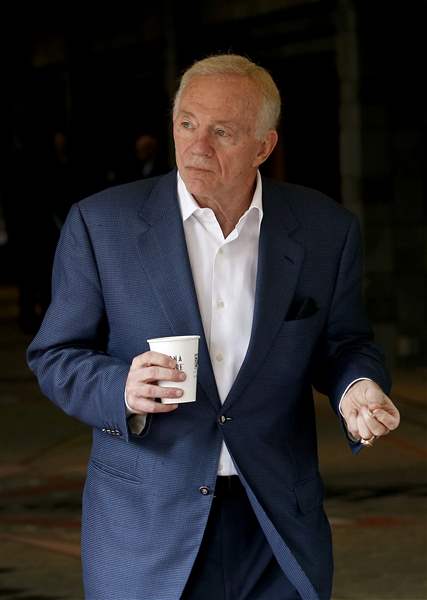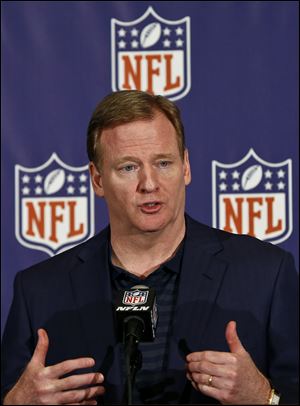
Player safety rules passed by NFL owners
NFL owners concentrate on player safety rules at meetings
3/21/2013
Dallas Cowboys owner Jerry Jones leaves the owners morning session after it adjourned at the annual NFL football meetings at the Arizona Biltmore, Wednesday, March 20, 2013, in Phoenix. (AP Photo/Ross D. Franklin)
ASSOCIATED PRESS

NFL Commissioner Roger Goodell answers a question from the media during a news conference at the annual NFL football meetings at the Arizona Biltmore, Wednesday, March 20, 2013, in Phoenix.
PHOENIX — The NFL believes it made pro football safer, particularly for defensive players, with rule changes passed at the owners meetings.
Team owners on Wednesday barred ball carriers from using the crown of their helmets to make forcible contact with a defender in the open field. The previous day, they eliminated the peel-back block everywhere on the field.
“This meeting is primarily about evaluating our rules both from a safety standpoint and what we think we can do to improve and make the game better,” Commissioner Roger Goodell said. “We made some very significant progress on both of those fronts.”
The second significant player safety rule passed this week came with much debate — and some criticism, naturally, from running backs. Several coaches and team executives expressed concern about officiating the new rule, but Goodell championed it and it passed 31-1. Cincinnati voted no.
But if it was good enough for football's greatest running back, NFL owners figure, it should work in the 21st century.
“Jim Brown never lowered his head,” Pittsburgh Steelers president Art Rooney said with a smile. “It can be done.”
The changes were the latest involving safety, and head injuries in particular, with the issue receiving heightened attention amid hundreds of lawsuits filed by former players claiming that the NFL did not do enough to prevent concussions in years past. League officials have defended the NFL's record and did so again Wednesday.
“I have always thought that player safety has been at the forefront of our discussion for a long, long time,” said Atlanta Falcons President Rich McKay, co-chairman of the competition committee that recommends rule changes. “The game has gotten safer over time. Where we have really focused is on the big hits, the open field hits and hits where players truly can't defend themselves. In this step that we are taking, we are trying to protect the player from himself with respect to this rule.”
The tuck rule, one of the most criticized in pro football, was eliminated. Now, if a quarterback loses control of the ball before he has fully protected it after opting not to throw, it is a fumble.
The Steelers were the only team to vote against getting rid of the tuck rule. New England and Washington abstained.
“We have so many continuing action plays, it's a different scope,” said Ravens coach Marvin Lewis, also a member of the competition committee. “Because of the evolution of replay and putting turnovers into automatic reviews, it just seemed like an easier transition to make right now.
“It was put in before for player safety, but it is not being ruled as that. There's a mad scramble for the ball.”
Peel-back blocks had been legal inside the tackle box, but now players can't turn back toward their goal line and block an opponent low from behind anywhere on the field.
Video review now will be allowed when a coach challenges a play that he is not allowed to. But the coach will be penalized or lose a timeout, depending on when he threw the challenge flag.
That change stems from Houston's Thanksgiving victory over Detroit in which Lions coach Jim Schwartz challenged a touchdown run by the Texans’ Justin Forsett. Although officials clearly missed Forsett being down by contact before breaking free on the 81-yard run, when Schwartz threw the red flag on a scoring play that automatically is reviewed, the referee could not go to replay.
That loophole has been eliminated.
Goodell was eager to get approved the competition committee's proposal to outlaw the use of the crown of the helmet by ball carriers, and there was talk the vote would be tabled until May if the rule change didn't have enough support.
But after watching videos of the play that clearly showed the differences in legal and illegal moves by ball carriers, the owners voted yes — and then applauded the decision, something Rams coach Jeff Fisher said is “rare.”
“We had discussions with the players association and the players themselves, the coaches’ subcommittee,” said Fisher, co-chairman of the competition committee. “A lot of people talked to us about this rule and how to roll it out in our game.”
The penalty will be 15 yards from the spot of the foul, and if the offensive and defensive players both lower their heads and use the crown of the helmet to make contact, each will be penalized.
“It'll certainly make our runners aware of what we expect relative to use of the helmet,” Cowboys owner Jerry Jones said. “One of the questions I ask a lot is who gains from this, offense or defense? And it's a toss-up as to which side of the ball has the advantage on this rule, if any. The main thing is it's pro-health and safety, and that's the big thing.”
The owners discussed simply using fines on ball carriers to eliminate the tactic, but instead voted to make the rule change.
Goodell announced that the Pro Bowl will be held in Honolulu on Jan. 26, the Sunday before the Super Bowl. The commissioner has considered scrapping the all-star game, but was satisfied with the level of performance in this year's matchup, won 62-25 by the NFC.
He added that the system for choosing the players won't change, but some consideration has been given to having team captains select their rosters, rather than an AFC vs. NFC format.
The Rooney Rule that requires every team to interview at least one minority candidate when there is a coaching or general manager opening was discussed at length. This year, with eight coaching vacancies and seven for GMs, no minority candidates were hired.
Goodell said he was disappointed in those results and would like to see more flexibility when teams ask to interview candidates whose clubs still are playing.
“One of the major focuses we've had was that we are going to reinstate the symposium program that we've had in the past,” Goodell said. “That was primarily focused on coaches, but we are likely to have some potential GM candidates also attend with the coaches.”
The owners also approved tight ends and H-backs wearing numbers between 40 and 49. Previously, they were supposed to have numbers in the 80s.